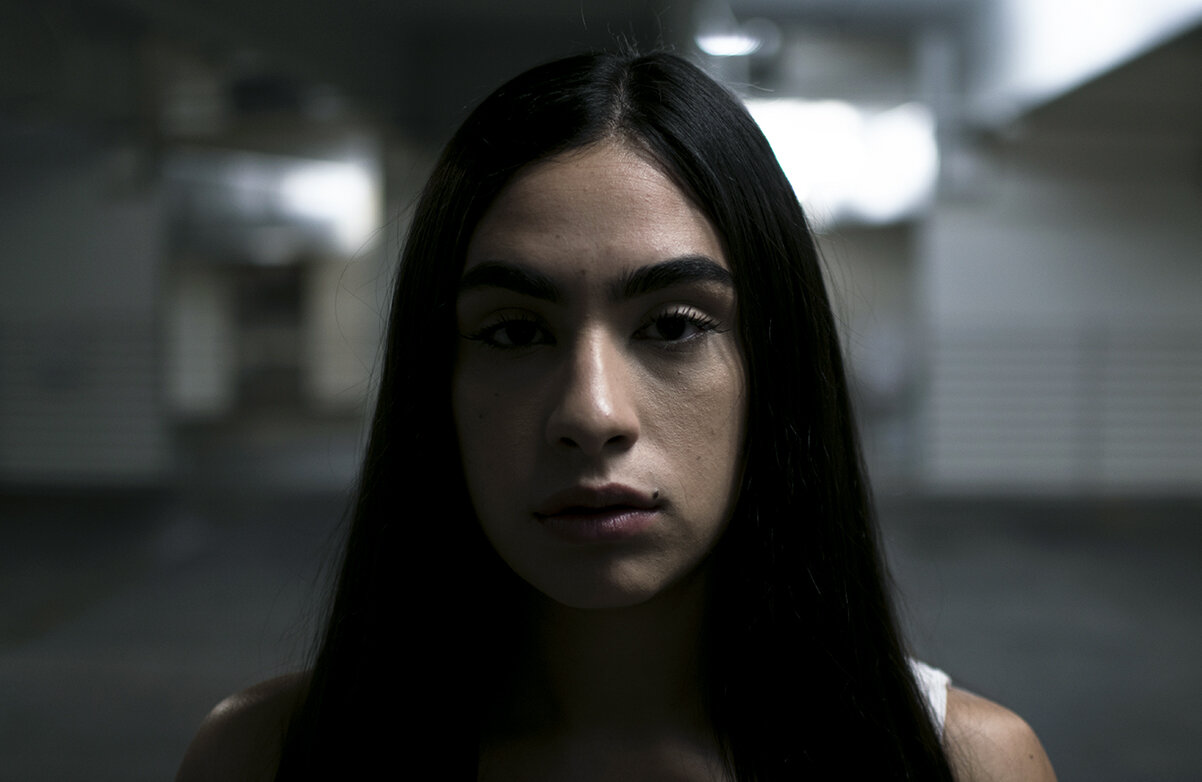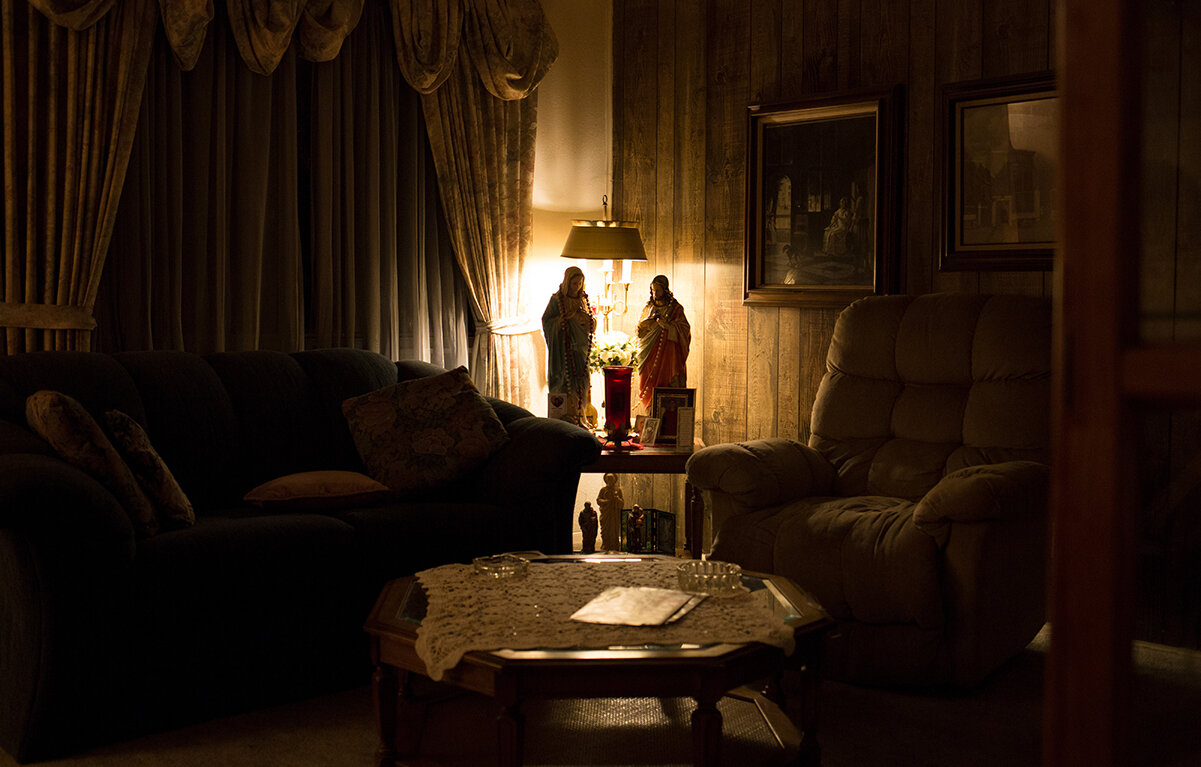The Gallegos Twins from Belen, NM © Frank Blazquez
In 2010, Frank Blazquez moved to Albuquerque, New Mexico from Chicago, Illinois to start fresh, onward from the drug-enveloped party culture taking over his life. As a certified optician, he landed a job at an optometry office and his path looked up. While he initially connected with a sober crowd, he started spending time in Albuquerque's “War Zone,” – one the most crime-ridden neighborhoods in the city – began selling and taking Oxycontin, and eventually lost his job. This continued until 2016 when he got clean, inspired by fellow addicts failed attempts to break their endless cycles, and the desire to use a camera to tell their – and his own – stories. His experience as an optometrist added a layer of curiosity towards how a lens could reimagine a person’s identity and representation.
Blazquez initially began making portraits of former addicts and formerly incarcerated individuals who called Albuquerque home. His portraits were an attempt to create humanistic counter-narratives of people who popular culture often stereotypes or misrepresents. After sharing a few images on Instagram in 2017, he began receiving requests from a wide swath of people connected by New Mexican Spanish-speaking heritage asking him to make their portrait. His work has since evolved to tell a story of Latinx culture in Albuquerque and other areas in New Mexico.
Documentary portraiture has a complicated history and legacy. It’s often tainted with objectification and outsider views - from Edward Curtis’s early tintypes of Native Americans to National Geographic’s (thankfully now updated) decades of representing indigenous communities through a Western lens. What makes Blazquez’ work stand apart is not only its pronounced humanism but his personal and cultural connection to the people he photographs. He uses photography to describe his shared experience.
Jon Feinstein in conversation with Frank Blazquez
Carlos © Frank Blazquez
Jon Feinstein: You describe your work as creating "counter-narratives." What narratives are you looking to break?
Frank: Blazquez: Today's television and film productions (Breaking Bad, Better Call Saul, etc.) still rely on token Old West stereotypes. These prototypes are portraying Southwest Latina/o culture with blanket characterizations such as: New Mexican barrio fashion (street/urban) consisting mainly of Mexican cartel-type clothing with no visible tattoos.
Feinstein: How does this work address that?
Blazquez: My counter-narrative presents authentic Hispanic New Mexican signifiers: single-needle prison tattoos showing specific historical events in New Mexico, New Mexican-types of chain links for necklaces and bracelets, specific styles of shirts/pants/shoes and dominant colors (oftentimes transferred via cultural exchange from California/Arizona/Texas), and vernacular.
Feinstein: Can you tell me a bit about your process of working with the people you photograph?
Blazquez: Some of my portrait subjects have drug addiction issues and prison backgrounds. The rest are just fascinating examples of New Mexican Latina/os—people born in New Mexico identifying along the Spanish speaking spectrum (Hispanic, Spanish, Mestiza/o, Mexican, Mexican-American, Afro-Latino, Latinx, Chicanx, etc.). I make selections based on a number of different factors including fashion, home objects, and connected icons.
Miranda © Frank Blazquez
Aubrey in Her Grandparents Living Room. © Frank Blazquez
Feinstein: Thinking more about your work and this sense of warmth, empathy and shared humanity in everyone you photograph, I start thinking back to August Sander, and his goal of documenting a truly democratic, inclusive and humanistic view of the German people in the early 20th century, one that broke from the narratives Hitler was trying to portray. While your work is visually very different, do you see a kinship to Sander as a humanist/documentarian?
Blazquez: A glimpse inside a world we'd otherwise not have access to, Sander's portraits are wonderful examples of humanity post-World War I. In the same vein, I enjoy human portraits from major figures of the FSA years, also, Kevin Bubriski and Miguel Gandert who unveiled much of the northern New Mexican region in their time. At the moment I'm looking at work from Philip-Lorca diCorcia, and re-reading Learning Las Las Vegas (a wonderful piece on Southwest architecture), and works from Deleuze and Barthes.
It is amazing to see the connections of photography within many fields of study--but it might be too early to see my placement within all of this. When I read how the camera relies on quantum physics to operate and its relation to human evolution (evolution of the human eye from 555 mil. years ago to man-made versions of a retina via Camera Obscuras), I feel there is so much more for me to understand in mediating life through transparent lenses.
Frank Blazquez and his work in Representing the West, Sangre de Cristo Arts Center, Pueblo, CO, 2019
Amy Rivera © Frank Blazquez
Feinstein: How has photography helped you work through your own experience with addiction?
Blazquez: Human portraits reflect accessibility. A portion of my initial street-portrait portfolio are former friends from my chaotic memories in Albuquerque. Returning to those dark environments felt like coming back "home" for a short visit—think college freshman on holiday break—making amends with the hometown girlfriend on the long-distance relationship I promised would work out.
Feinstein: In one of your Guardian pieces, you mention that many of your subjects came from people finding you on Instagram/ asking to have their portrait taken. Have your portraits been helpful for them in the ways they’ve been helpful to you?
Blazquez: A few of my portraits gained local popularity in 2018 on Canyon Road in Santa Fe, SITE Santa Fe, and various exhibitions around northern New Mexico. Given these events, subject selection was easier as opposed to my 2017 method of earning street-photography stripes by walking up and down Albuquerque's War Zone streets.
Also, some of my subjects lack the formal equipment used to obtain high-quality imagery–portraits made from 55 - 85mm primes at 1.8 - 2.2 are big differences compared to their cellphones. Some of my subjects use the portraits on their social media, and some do not. Pertaining to my portrait publications in The Guardian, VICE, Remezlca, etc., several of my subjects have not seen them. I discovered it's a luxury to able to sit down and read photography articles and art periodicals.
Justine and her Daughter © Frank Blazquez
Felipe’s Reflection © Frank Blazquez
Feinstein: I'm drawn to your use of the words "surviving on borrowed time." Can you elaborate on this idea?
Blazquez: It speaks to living life on a different timeline—similar to reliving past moments through photographs—almost like I was not supposed to be here. Emotions of regret and urgency come to mind.
Feinstein: WIth your recent attention in The Guardian, local press, and exhibitions, what kinds of responses have you received to the work?
Blazquez: When I got the March 2020 cover of the local art magazine Southwest Contemporary, people around various locations in downtown Albuquerque threw the magazines on the streets and littered them around town—then shattered the windshield of my car on the morning it was published.
On my YouTube channel where I film short documentary vignettes based on my portraiture, people comment things like: "You should kill all these wetbacks and build the wall," and "They have no hope, just shoot em' in the head and euthanize them." I guess It comes with the territory, but I usually find it interesting how simple images move people toward certain poles.
Gutierrez-Padilla Living Room © Frank Blazquez
Feinstein: You mentioned that your work also had some issues on Facebook in 2017.
Blazquez: It started with many people "reporting" my portraits. Possible enemies of my subjects, or people that just wanted them erased, I started to get "temporary blocks" one after the other, each block or "punishment" getting longer after I posted a new portrait. Then I just got fed up with appeasing Facebook rules on street portraits that neither contain nudity nor hate speech, so I switched to using Instagram primarily. Although IG is tied to Facebook, I do not experience ridiculous sanctions on that platform.
Feinstein: I recall a recent post on social media in which you mentioned that initially, some curators told you your "type of photography" didn't belong in the art world. Personally, I think lines are blurry and statements from "gatekeepers" like this are ridiculous. Why do you think these curators responded that way?
Blazquez: In 2018, I had a curator visit for local artists to receive feedback on content. They told me , "To be honest, if I were managing a gallery here, I would never sell prints like these. They are not part of what sells in the art world." I guess the criticisms were meant to give artists different marketing techniques, but that comment resonated with me. It also allowed me to realize that documentary style portraits of Hispanic people are rarely seen on walls.
Sedrick from Northern New Mexico © Frank Blazquez
The Blazquez Family - from the series Mexican Suburbs © Frank Blazquez
Feinstein: You've also been working on another series - Mexican Suburbs – cut-up collages and other mixed media pieces. How does this fit into your larger practice/ experience?
Blazquez: They are part of my project Mexican Suburbs. I work with cannibalized archival prints and mixed-media to draw on my own Mexican-American experience. I like working with fragmented items that pertain to my opiate recovery process and my relationship to nostalgia and personal triggers.
Feinstein: How do you see your Southwest Stories series continuing/ changing/ coming to an end?
Blazquez: I said it would only be a 1 to 2-year project, but I am going past those dates now. I have enough subject matter to do this until I die, so we'll see what happens.











